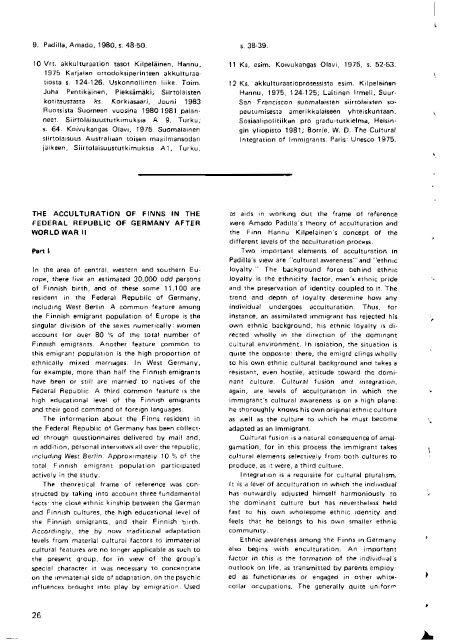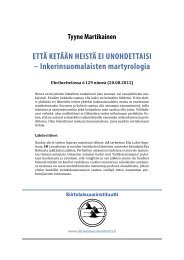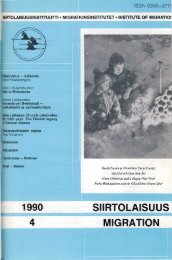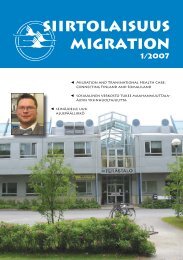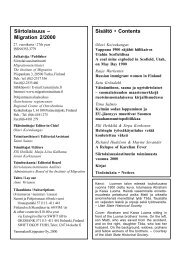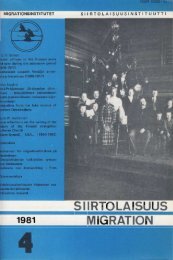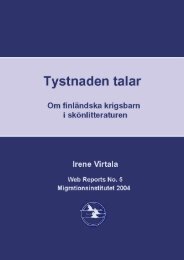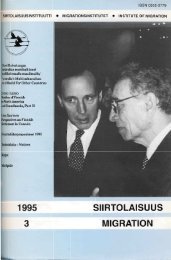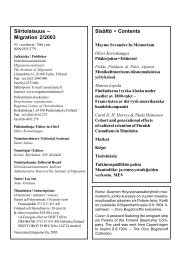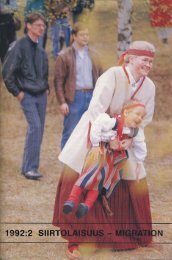1986 - 1 - Siirtolaisuusinstituutti
1986 - 1 - Siirtolaisuusinstituutti
1986 - 1 - Siirtolaisuusinstituutti
You also want an ePaper? Increase the reach of your titles
YUMPU automatically turns print PDFs into web optimized ePapers that Google loves.
L Padilla, Amado, 1980, s. 48,50.<br />
10 Vrt. akkulturaation tasot Kilpelainen, Hannu,<br />
1975 Karjalan onodoksiperinreen akkutiLrraa<br />
tiosta s. 124,126. Uskonnollinen liike. Toim.<br />
Juha Pentikeinen, Pieksamdki; Sairtolaisten<br />
kotitaustasra ks. Korkiasaari, Jouni 1983<br />
Ruorsista Suomeen vuosina 1980 1981 paiann€et.<br />
Sijrtolaisuusrutkimuksia A g, Turku;<br />
s.64. Koivukangas Ola!|, 1975. Suomalarnen<br />
srrrlolaisur.rs Australtaan loisen maailmansodan<br />
jelkeen, Siirtolaisuustutkimuksia A1, Trjrku,<br />
THE ACCULTURATION OF FINNS IN THE<br />
FEDERAL REPUBLIC OF GERMANY AFTER<br />
WORLO WAR II<br />
Prrt I<br />
In the area of central, western and southern Eu<br />
rope, there live an estimared 3O,0O0 odd pefsons<br />
of Finnish birth, and of rhese some 11,100 are<br />
residenr in the Federal Republic of Germany,<br />
ncludrng West Eerlin. A common feature among<br />
the Finnish emigrant population of europe s the<br />
singular division of the sexes numencal y: women<br />
account lor over 80 '/o of the toral numb€r ot<br />
Finnish emigrants. Another feature common to<br />
thjs em'granr populalron is the high proporiion of<br />
ethnically mixed marflages. In Wesr Germany,<br />
.or erdmple, morp lhan hdlt lhe F nnrsh emigrarls<br />
have been o/ still are married to natives of the<br />
Federal Republic A thifd common feature rs the<br />
high educational level of thp Finnr5h emrgrsnts<br />
and their good command of forergn langLrages.<br />
The information about the Finns resident in<br />
the Federal Republic of Germany has been collected<br />
through questionnaires delivered by mall and,<br />
n addition, personal intervlews ell over the republic,<br />
rncludrng West Eerljn Approxrmarely 10 9Z of rhe<br />
rotal Frnnish emigrant populat on particrpated<br />
aciively in the sludy.<br />
The theoretical frame of refer€nce was con<br />
structed by takinq into accounr three fundamenral<br />
facrs rhe close ethnic ki^ship between rhe German<br />
and Finnish cultures, the high educaiional level of<br />
rhe Finnish emigrants, and their Finnish blrth.<br />
Accordingly, the by now tiadjtjoDal adapiation<br />
levels from material cultLrral factors ro immaterial<br />
culiura features are no longer applicable as such to<br />
rhe present gfo\rp, lor in view ol the group s<br />
speclal character it was necessary to concentrate<br />
on the rr.mater|al side of adaptarion, on the psychlc<br />
rnfluences brought rnto p ay by emigration. Used<br />
26<br />
s.38-39.<br />
1'l Ks, es;m. Koivukangas Olavi, 1975, s. 52-53.<br />
12 Ks. akkulturaatiopros€ssista esim. Kilpel6insn<br />
Hannu, 1975, 124'125; Lairinen lrmeli, Suu.<br />
San F.ancjscon suomalaisteh sijrrolajsteri so'<br />
peutumisesta amerikkalaiseen yhteiskuntaan.<br />
Sosiaalipolitiikan pro gradu-tutkielma, Helsingin<br />
yliopisto 1981; Borrie, W. D. The Cultural<br />
lntegration of lmmig.ants. Paris: Unesco 1975.<br />
as ards In worklng out th€ frame of reference<br />
were Amado Padilla's theory ot accultura on .nd<br />
the Finn Hannu Kilpel€inen's concepr of the<br />
different levels of the acculturatjon process.<br />
Two important elements of acculruration in<br />
Padilla s vtew are "cullural awareness" and "ethntc<br />
loyalty. The backgfound force behind ethnic<br />
ioyaJry is the ethnicity facior, man's elhnic prjde<br />
and the preservation of identiry coupled ro it. The<br />
trend and depth of ioyalty determine how any<br />
individual undergoes accullu.atisn. Thus, for<br />
instance, an assimilated rmmigrant has.eject€d his<br />
own ethnic background; his ethnic loyalty is di<br />
recled $/holly in the direction of the domtnant<br />
ct/ltural environment. ln isolation, the situation is<br />
qurte the oppostte: the.e, the emigrd clings wholly<br />
to his own ethnic cultural backgfound and takes a<br />
resistant, even hostile, atritude toward the dominant<br />
(ulture Cullir'il iusion dnd rn'egrdr'on,<br />
again. are levels of acculturatron in which ihe<br />
immigranr's cultural awareness rs on a high plane:<br />
he thoroughly knows his own origrnal e(hnic cUlture<br />
as we I as the culture to which he must become<br />
adapted as an immigrant.<br />
Cult!.al tusion is a natural consequence of amal<br />
gamation, for in this process the immigrant takes<br />
culrural elsments selecrively trom both cultures to<br />
produce, as i were. a third culture.<br />
Integra|on is a reqursite for cultural pluralrsm.<br />
It is d leler of acculturarron in which the individ!al<br />
has outwardly adiusted himself harmoniously to<br />
ihe dominant culrure but has nevertheless held<br />
lasr to his own whol€some elhnic rdeniity €nd<br />
feeis thar he belongs to his own smatler ethnic<br />
Eihnic awareness among the Finns In Germany<br />
also begins wirh encLrlturarion. An important<br />
{dctor in this is rhe lormarion o{ ahe individlal s<br />
outlook on lile, as transmitted by parents employ<br />
ed as lunctionaries or enqaged in oth€r whit€,<br />
collar occ!pations, lh€ generally quite un forr


